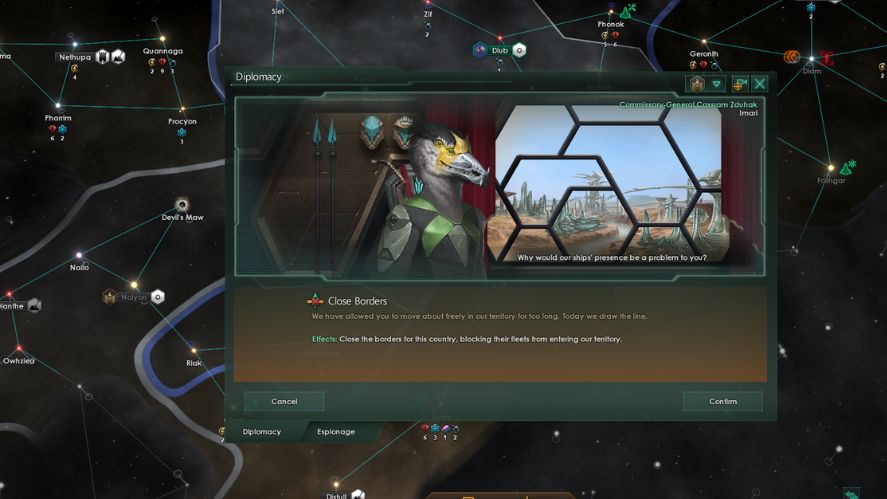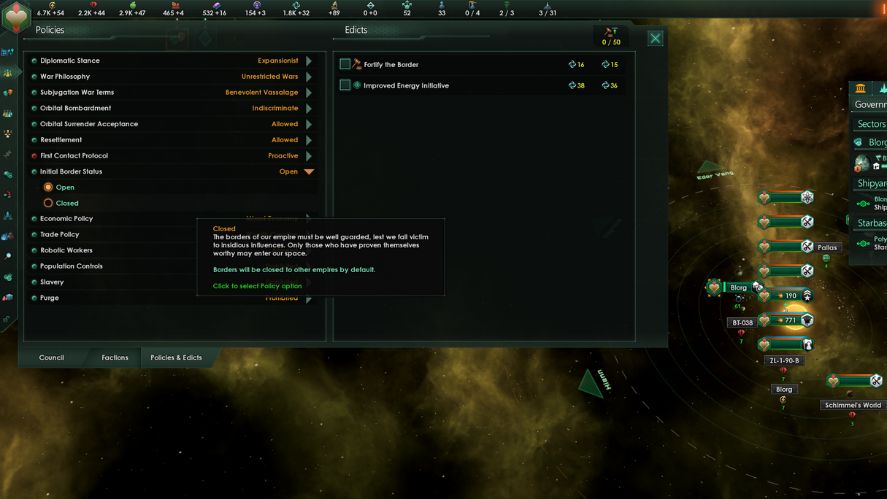Nobody wants their nosey neighbors coming into their backyard and snooping around. That even holds true for space-faring mega-nations with populations in the trillions.
If you don’t want other space empires to enter your space, you can close your borders to them and prevent access. This guide will teach you all the different ways to close your borders in Stellaris.
Recommended Read: Stellaris – Best Starting Setups
While closing borders is a quick and easy process, there are limitations to who you can and can’t block from entering your space.
You can close borders in Stellaris either via the diplomacy screen, by setting a closed border policy, or by declaring someone a rival.
Table of Contents
How to Close Borders in Stellaris
Allowing other space-faring nations into your borders is not always the wisest of moves. They can scout out your defenses, find where you are vulnerable, and, worst of all, they may notice that you were planning to attack them first.
In competitive multiplayer games, forgetting to close borders with your fellow players can be a fatal mistake.
There are other reasons to close borders: you could be role-playing as a xenophobic empire, or you may not like the look of the aliens living next door to your systems.
Whatever your reasons, you will want to know each of the three methods you can use to close borders to other empires.
Closing Borders Through the Diplomacy Screen
The easiest way to close borders is by using the diplomacy screen. It only takes a few clicks, and the application of closed status is instant.
To do this, open the diplomacy interface with the empire you wish to block from entering your borders.
You can open the diplomacy menu by clicking on their flag or by finding them on the contacts menu (the shortcut is F10 by default).
One of the options on the diplomacy interface will read “Close borders.” Click that option, hit confirm, and as easy as that, your borders are now closed.
Any of their ships in your space will disappear from your territory, and they won’t be able to get back in.

There are a few restrictions on who you can close your borders to that you should be aware of. If you are already rivals with the target empire, you cannot close your borders to them; more on this later in the guide.
If you are in the same federation, you cannot close borders with them. There is no way to change this, not even via federation law or galactic community resolution. Overlords and vassals cannot block access to each other either.
Finally, you cannot close borders with someone you have a truce with. Truces are always called after wars conclude. This is to give each side time to retreat their forces before borders are likely to close again.
Closing borders this way will reduce relations by 20 points and come with a trust cap of 50.
Declaring a Rival to Close Borders
Another option you have for closing borders is declaring another empire your rival. Doing this will more than likely ruin your relationship for a very long time, but you didn’t get along anyway.
If you are declaring someone a rival, the reason is seldom to have closed borders with them. The closed borders are a happy consequence of declaring someone your rival.
The rules around rivalry are quite simple; they are what the game calls unilateral agreements. This is a fancy way of saying that the other party has no say in whether the agreement happens or not.
To declare a rival, you must first have terrible relations with the empire in question. You can get this by fighting wars with them, sending insults, making claims on their territory, and, in general, being a big meanie to them.
Declaring a rival grants you an extra 0.5 influence per month, closes borders with them, lowers opinion by 100, grants the animosity casus belli, and reduces claims on their systems by 20%.
Declaring a rival is done through the diplomacy screen.
Setting Your Border Policy to Closed
The third way of closing borders to other empires is by changing the initial border status on the policies menu.
Policies is a submenu on the government page (F2 by default). Open that, then click the policies and edicts tab at the bottom.
This will open two menus at once, with policies on the left and edicts on the right. If you do not know much about the policies menu, you should change that posthaste. This menu allows you to change your empire’s laws, economic policies, stances on slavery, and a lot more.
The policy that matters for this guide is the initial border status policy. There are only two options for this policy: open or closed.
An important note: this policy dictates the border policies of any new empire you meet. What that means is that if you have already met an empire, changing this policy will not change the current border status.
After setting it to closed, any new empire you meet while exploring space will be blocked from entering your borders by default.
You will still have to close borders via diplomacy to empires you met before setting the closed policy (explained earlier in the guide).

If you change the border status, there is a ten-year cool down before the policy can be changed again.
Your border status does not affect the other methods of closing borders explained earlier in the guide. You can still open and close borders at will by using the diplomacy menu.
This is everything you need to know about how to close borders in Stellaris.
If you have any questions or suggestions for this guide, please let us know in the comments section below. As always, have fun keeping those pesky aliens out of your borders in Stellaris.




